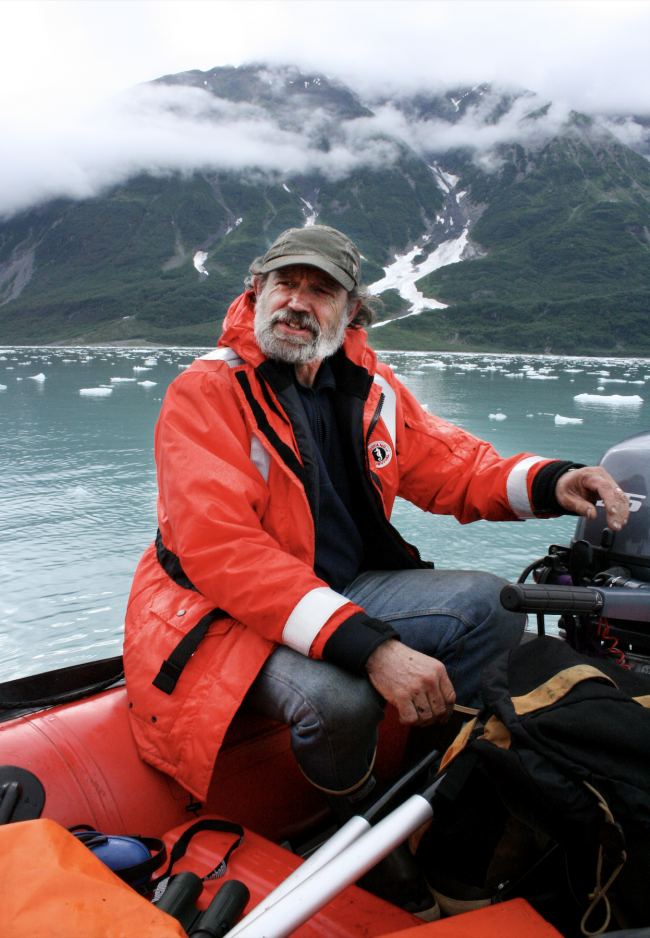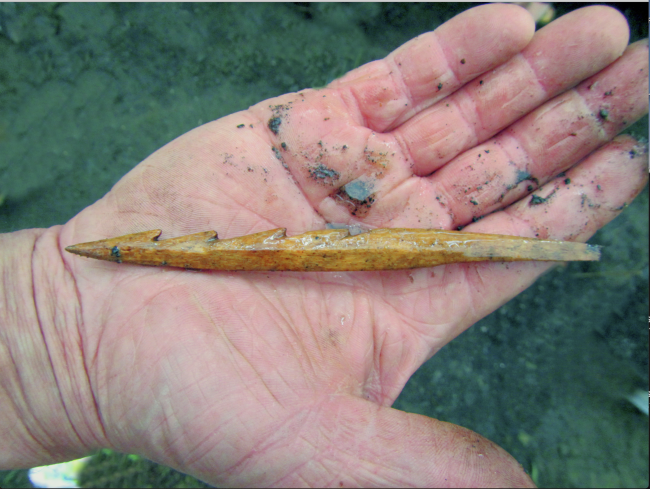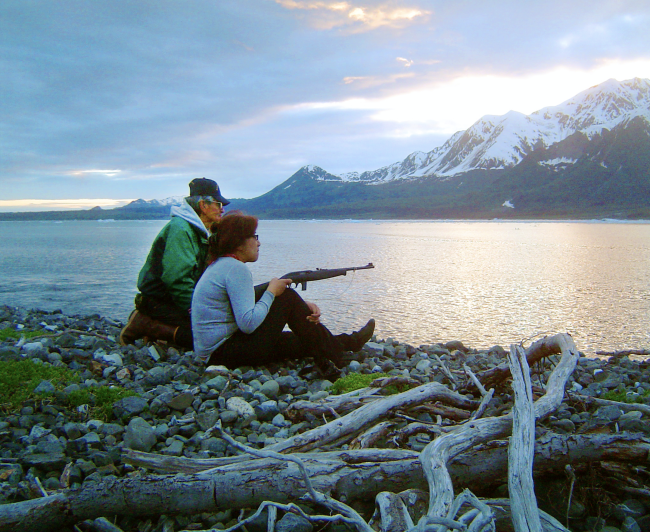How Indigenous Oral Tradition Is Guiding Archaeology and Uncovering Climate History in Alaska
This article appeared in the March/April issue of Discover magazine as “Speaking the Past.” Subscribe for more stories like these.
On the Copper River in south-central Alaska, a celebrated chief named Łtaxda’x (EL-tax-da) once owned a dish hewn from the horn of a giant moose. When Łtaxda’x died, four brothers fought over this ceremonial platter of the Raven clan. According to some tellings of the ancient story, one brother who lost gathered the people who sided with him and led them away from their ancestral home into the unknown.
They journeyed for many years, crossing a glacier and nearly starving. When they followed what looked like a rabbit on the snowy horizon, it turned out to be the distant peak of Mount St. Elias. From the top, they could see the deep blue sea, and they built their home on an island. They prospered under the protection of the mountain with the glacier spirit that adopted them and taught them how to hunt seals living there.
Their village, Tlákw.aan (KLAK-wan), grew to have so many people that smoke from hearthfires hung over the houses. These clouds led to an incident remembered by their descendants even today — generations after they abandoned Tlákw.aan and built a town on the nearby Yakutat mainland (350 miles from Anchorage in present-day Alaska). “It’s said that there was so much smoke coming up from the houses that Raven choked and fell from the sky,” says Aron Crowell, director of the Alaska division of the Smithsonian Arctic Studies Center.
Raven is a supernatural being in Indigenous cultures of Alaska — including the Yakutat Tlingit who identify Łtaxda’x as a forebear. The winged creature performs cosmological feats, such as releasing the sun, moon and stars into the heavens. (An image of Raven by a Tlingit artist was recently selected to appear on a U.S. stamp in 2021.) Many of his exploits illustrate morals that have educated generations of children through tales told aloud by their elders. Oral traditions of this kind are found in all cultures, and have served as a basis for written texts such as the Judeo-Christian Bible. Even when writing becomes predominant, oral traditions persist, as any child who has ever heard a bedtime story can attest.
Crowell knows the Indigenous Raven stories nearly as well as the people raised on them. He is also deeply familiar with Yakutat Bay on the Gulf of Alaska, where the Tlingit people claim to have been guided by the spirit of Mount St. Elias, the mountain that first appeared as a rabbit. As an archaeologist, Crowell has found copper artifacts on the land the Tlingit still occupy, and has seen trace metal analyses that prove the alloy originated a couple of hundred miles away on the Copper River. Guided by oral legends, Crowell’s findings revealed that the migration story of the Tlingit ancestors is essentially true.
His research, conducted with partners from local communities, is revealing the history of Alaskan settlement, buttressing Native claims to their rightful territories and providing new insights into historical climate fluctuations that may help people cope with environmental changes to come. Other researchers are also enlisting oral tradition to study places such as Australia, where narratives may have been passed down since the last Ice Age. An important piece of the past remains present for these researchers with a receptive ear. Results are proving that to be a good scientist is to be a good listener.

Aron Crowell.
(Credit: Smithsonian Institution)
Learning From Oral Tradition
In 2011, Crowell traveled to Knight Island on Yakutat Bay, where a small settlement had been excavated in 1952. The settlement was thought to be Tlákw.aan, but there weren’t enough hearths to disorient a honeybee, let alone fell the mystical Raven. Crowell surmised that most of the village had not yet been uncovered. With shovels and a bevy of students — some from the Tlingit community — he began excavating. They discovered that the Knight Island sediment hid an entire 500-year-old village.
“These stories are carrying forward eyewitness information from the past,” says Crowell, seated in the Arctic Studies Center’s Alaska headquarters. Crowell is lean with a tidy gray beard and hair just long enough to let you know he’d rather be outdoors. He gazes out on the drab Anchorage skyline, then back at a bank of file cabinets containing thousands of pages of transcript. “From oral tradition, we know who lived in a place and why they were there and where they came from.”
The potential of oral tradition to locate artifacts of the past, and to reveal their significance, has made Crowell into a kind of intellectual cross-athlete. He combines archaeology, anthropology, linguistics and climate science — and a commitment to open-mindedness. This mix of disciplines has proven to be especially potent in Indigenous contexts because oral tradition is often central to Native communities, which have been marginalized for centuries by Western science and society. “It’s about decolonizing anthropology,” says Crowell.“It’s part of a larger story of anthropologists and archaeologists reconnecting with Indigenous peoples on an equal basis.”
He isn’t alone in this mission. “It’s very powerful for Native peoples’ point of view to be respected, to see that our knowledge is just as valid as Western science,” says Judith Ramos, a member of the Yakutat Tlingit clan and an anthropologist at the University of Alaska Fairbanks. She has worked alongside Crowell as a co-investigator on the Yakutat Bay project. “Indigenous knowledge can enrich scientific knowledge. They can be mutually enriching.”
Weeding Racist Roots
“Indian tradition is historically worthless,” declared Robert Lowie in the prestigious Journal of American Folk-Lore in 1917. Lowie was a curator at the American Museum of Natural History, and considered a leading authority on Indigenous history throughout the first half of the 20th century, a time when racism was as commonplace as tweed.
Lowie’s work as an anthropologist had led him to question the accuracy of oral traditions, and to scorn what he called the “primitive tribes” that espoused them. As an example, he cited an Assiniboine legend in which humans and horses are both created at the beginning of time. He claimed the elders should know better, given that horses had only recently been introduced to North America.
Lowie was hardly alone in his derision. But even in the early 20th century, the methodology that Crowell uses successfully today was emerging through the work of a young anthropologist named Frederica de Laguna.
De Laguna began her research with the ambition of solving what was then called the “Eskimo problem” — determining where Inuit culture originated, and how the Inuit descended from Paleolithic peoples. But fieldwork she began in the 1930s instilled in her a skepticism toward overarching theories. Instead of trying to compare Inuit art to Paleolithic objects, she began talking to people, collecting their memories. She visited Greenland and the Yukon, and spoke to some of the last surviving members of the ancient Eyak tribe on the Copper River. Her deepest and longest lasting engagement, however, was with the Tlingit of Yakutat Bay, which are not part of the Inuit tribes farther north.
Over five years in the early 1950s, de Laguna lived with the Tlingit and collected their stories, many of which had never been written down. Her research led to a 1,400-page English-language monograph published by the Smithsonian Institution, still used as a standard reference by the tribe. De Laguna is also the one who, guided by oral traditions, led the first excavation of Knight Island and found traces of Tlákw.aan.

This 500-year-old barbed arrow point came from the Tlákw.aan village site.
(Credit: Smithsonian Institution)
Crowell remembers working with de Laguna on a Kodiak Island excavation in the 1980s, when she was in her late 70s and celebrated as a dean of Alaskan anthropology. Her method stood in contrast to Lowie, who “felt that things very quickly became mythologized, and the transmission was very unreliable,” Crowell says. De Laguna, by contrast, “took oral traditions very seriously, and applied archaeology to verify them.”
Deeming her a pioneer and an inspiration for his work, Crowell considers de Laguna’s success to be an outcome of her interest in archaeology, linguistics and anthropology. “She felt that she needed to be adept in all of those fields,” he says, “and to tie things together holistically.”
When Listening Becomes Digging
On a large round table at the Arctic Studies Center, Crowell is arranging gear for an expedition. He stuffs professional video cameras and microphones, cables and batteries into packs, intended to capture every nuance of his subjects’ speech as well as gestures used during ceremonies or out on a hunt. “There’s sort of a Hollywood production kind of aspect to launching a big field project,” he says.
The mixture of cameras and shovels reflects Crowell’s polymath background. Taking undergraduate anthropology classes at George Washington University in the mid-1970s, he was invited to spend a summer doing fieldwork in Labrador with a team from the National Museum of Natural History. Following a harrowing journey by small boat on an ocean teeming with icebergs, he began excavating a 7,000-year-old Indigenous settlement on the Arctic coast. “I was totally hooked,” he recalls. He might have gone back the following summer — and spent his whole career digging up remnants of extinct civilizations — had one of his anthropology professors not turned him around and put him on a plane to Botswana.
They were excavating a Middle Stone Age site, but it turned out that many of the prehistoric hunting techniques were still practiced, so he turned to local inhabitants for interviews. “You would ask them, ‘What do these archaeological remains mean?’ ” Crowell says. “It was a matter of going back into the ancient past by looking at contemporary knowledge.”
Crowell arrived in Alaska by way of his work in Labrador. The archaeologist who had brought him to the Arctic as an undergraduate, William Fitzhugh, was running the Smithsonian Arctic Studies Center, and wanted to open an Alaska field office. Crowell’s combination of interests, experiences and a Ph.D. made him the ideal candidate.
Over the next couple decades, he took up where de Laguna had left off in terms of connecting archaeology with oral tradition, with the benefit of new tools (such as radiocarbon dating). In keeping with the zeitgeist, he also brought an interest in connecting these fields to our changing climate.
Climates and Spirits
In 2011, George Ramos, a Tlingit elder (the father of Judith Ramos), proposed to Crowell that the Arctic Studies Center search for seal-hunting camps on the Yakutat Bay. “My dad was an expert in seal hunting,” Judith says. He knew of many seal hunting camps from traditional names of places and stories.
The camps were sacred because of their association with the spirits of ancestors who lived there, but many of the camps could no longer be located. The locations were also of interest to scientists seeking to understand climate history in the region, since each marked the ground closest to seal rookeries at the foot of Hubbard Glacier.
George and his wife Elaine Abraham, a Tlingit clan mother and founder of the Alaska Native Language Center at the University of Alaska, joined Crowell as co-investigators. They led a multi-year effort to preserve on video all the oral traditions about sealing. Judith joined them with a particular interest in seal hunting. When her parents died several years ago, she took their place as Crowell’s main collaborator.
“We don’t have any elders left,” says Judith. The vast trove of video offers one way for Yakutat culture to mitigate this loss. Another is the physical landscape itself. One of the most significant finds beyond Knight Island is a camp that is not only remembered in oral tradition but also visually documented by a scientific expedition. In the summer of 1899, the railroad magnate Edward Harriman funded a sea voyage up the Alaska coast, and famed photographer Edward Curtis documented a Yakutat hunting camp with many tents and smokehouses. Just four months after their visit, two major earthquakes radically altered the landscape. The camp was uplifted so far from the water that it had to be abandoned. The forest engulfed the old settlement over the next century.
“We spent a week thrashing around in the alder brush,” Crowell recalls. “We couldn’t see anything.” At last, a colleague’s metal detector started pinging as it swept over some rifle cartridges. The team carefully cleared away the overgrowth. They found everything to be exactly where it had been at the turn of the century. “You could compare it to Pompeii,” Crowell says.
The camp was rediscovered shortly before Elaine Abrahamand George Ramos died, allowing them to participate in a tobacco-burning ritual honoring the spirits of the drowned. The oral traditions they documented explained many of the discoveries, such as buried clusters of tiny moccasin beads. Passed-down memories of camp life tell of women stashing their beadwork before butchering seals hauled in by the hunters. The memories explain the beads, and the beads validate the memories, more evidence that oral tradition can inform archaeology and the climate history associated with it.
How Old Is Too Old?
Marine biologists are also learning to listen. For example, they’re gleaning insight from Judith Ramos’ survey of tribal memories about seal hunting. The survey showed how extraction of seals has been self-regulated by oral traditions about seals giving their lives only if hunters respect the meat. Killing without need is taboo for the Tlingit. This has led other researchers to investigate potential causes of recent population decline, including the routes of cruise ships — work that could inform governmental regulations that protect the seals and preserve the traditional Yakutat diet.

Judith Ramos, holding a .22-caliber rifle, waits for seals in Disenchantment Bay with her late father George Ramos. (Credit: Smithsonian Institution)
Contending with environmental change may in fact be a major reason why oral tradition is so reliable, maintaining fidelity over many generations. “When you’re passing on stories, you are preparing your children and their children and future generations to cope with the future and everything the future might throw up to confront them and to challenge their survival,” says Patrick Nunn, a geographer at the University of the Sunshine Coast in Australia.
Nunn has documented Australian Aboriginal oral traditions that he claims appear to be more than 10,000 years old in some cases. He believes some of these stories about coastal drowning describe the rapid melting of glaciers and rising sea levels at the end of the Pleistocene. “One-off events like this are important to know about, in case they happen again,” he says.
Even Crowell is wary of such extreme durability of memory. “To me, it just comes down to the number of generations, and what communication scientists would call information decay,” he says. “But I have an open mind about it.
“From my own work in Alaska, it’s clear that there is verifiable information going back 1,000 years, maybe 2,000,” Crowell says. If he succeeds in his work, the ancient stories might endure for thousands of years more into the future.
The “Floating” Fort Unearthed
Climate change has had a dramatic effect on the lives of Alaska Natives since the land was first populated. The conditions of the Arctic have amplified the impact of events such as the Little Ice Age — a 300-year temperature drop that started around the year 1500 — as well as human-influenced global warming today.
Memories of many of these changes were passed on by native tribes because subsistence living amidst glaciers is harshly unforgiving. Oral traditions and even place names recorded key climate events because knowledge of them could forewarn future generations.
Over the past couple of decades, Crowell has concentrated on coastal archaeology, interested in the combination of ethnic diversity and environmental peril. In addition toYakutat territory, he has spent time in Glacier Bay farther to the southeast, where his archaeological investigations have connected oral traditions to changes in relative sea level caused by the vast weight of glaciers compressing the land.
Ultimately, they found a lost fort said in oral tradition to have been the site of the first war of the world. According to legend, the fort “floated,” leading to its abandonment. Radiocarbon dating showed that the oldest parts of the structure were built a thousand years ago — when the region’s first compound bows fundamentally changed the nature of warfare — and the location is consistent with land that would have been flooded during the Little Ice Age.
“The head of the Hoonah Indian Association took elders and students to the site,” Crowell says. “It’s very powerful from the point of view of the people who live in these communities and have learned this oral tradition, but feel that that knowledge has never been respected.” It’s equally powerful for the scientists, who get to witness an ancient fort brought back to life. — J.K.
Jonathon Keats is a contributing editor to Discover. His most recent book is You Belong to the Universe: Buckminster Fuller and the Future.
